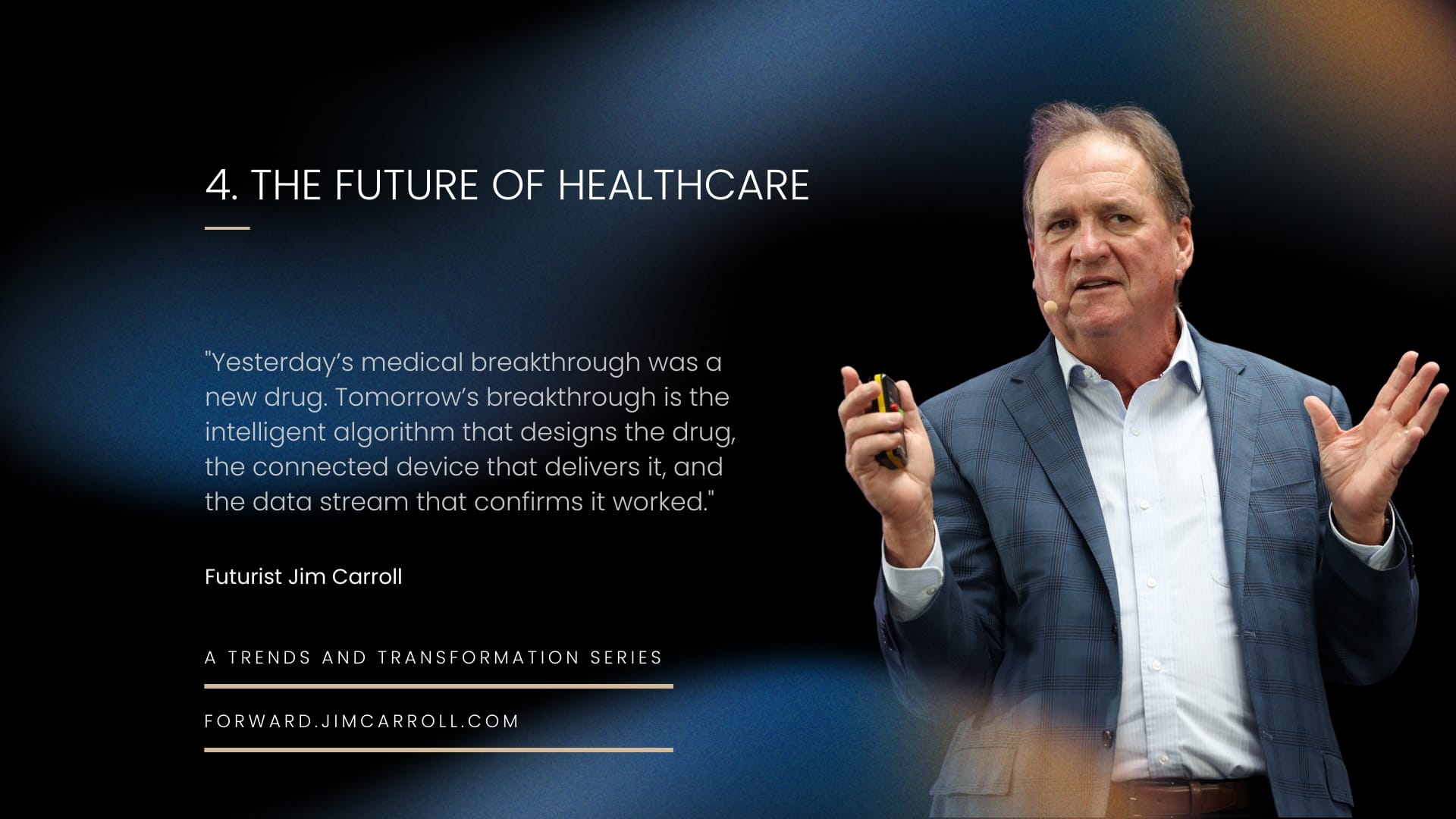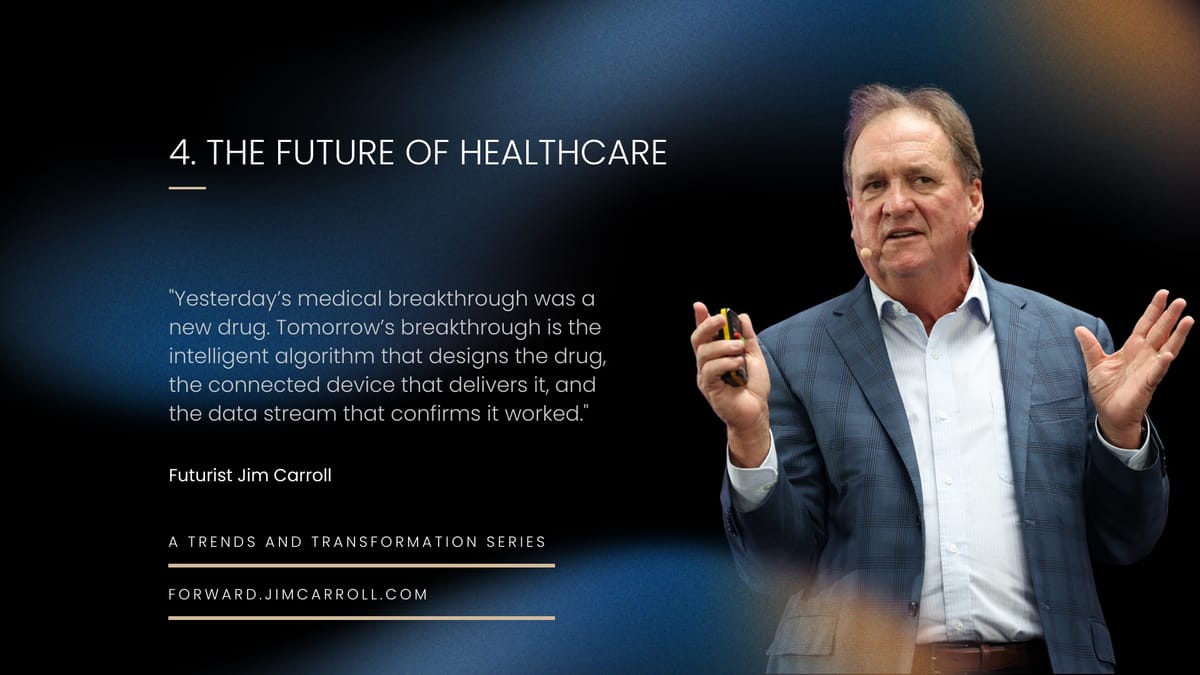"Yesterday’s medical breakthrough was a new drug. Tomorrow’s breakthrough is the intelligent algorithm that designs the drug, the connected device that delivers it, and the data stream that confirms it worked."- Futurist Jim Carroll

In 2025, the headwinds are severe, and the path forward seems shrouded in fog. We’re living through one of the most volatile and unpredictable periods in recent memory. With that being the case, I am writing this new series, The Way Forward: A Trends and Transformation Series, taking a look at the trends redefining industries, and actionable strategies organizations must pursue to align with these realities. The entire series will be found at forward.jimcarroll.com
This single idea captures the profound shift underway in healthcare.
Success is no longer measured by a single intervention, but by the intelligence of the entire system of care. It's a big undertaking, but one full of opportunity. Over the years, I've keynoted dozens of healthcare conferences, leadership meetings, and events, and have been writing on the topic extensively. Heck, in 1997, I released a book that predicted much of today's landscape called Good Health Online, not to forget that I predicted today's healthcare reality crisis - almost exactly as it is unfolding now - back in 2017.
Let's dig in.
The Landscape: 10 Trends Redefining Healthcare
If I look back at the topics I've covered, it's clear that the future of healthcare is being redefined at blinding speed. These are the 10 powerful trends creating both unprecedented challenges and massive opportunities.
- The shift to preventative medicine: The entire system is pivoting from a model that "fixes people after they're sick" to one of preventative, diagnostic medicine, driven by the plummeting cost of genomic science.
- The acceleration of medical science: Medical knowledge is now doubling in months, not years, leading to a furious pace of discovery in areas like gene therapy, regenerative medicine, and biomaterials.
- Bio-connectivity & the virtualization of care: The hospital as we know it is disappearing, extending its reach into the community and the home through a new generation of intelligent, Internet-connected medical devices.
- The rise of the empowered, connected patient: With wearable devices and real-time data, individuals are becoming active participants in their own care, creating a new "consumerization" of healthcare.
- AI-driven diagnostics and treatment: Artificial intelligence is becoming the new engine of healthcare, used to analyze medical images, accelerate drug discovery, and create personalized treatment plans.
- The data-driven healthcare dashboard: We are moving from episodic data collection to a continuous, real-time stream of health intelligence, enabling community-wide monitoring of emerging health challenges.
- The gig economy and the "just-in-time" medical professional: As medical knowledge fragments into hyper-specialized niches, organizations will increasingly rely on accessing the right skills at the right time for the right purpose.
- The redefined pharmacy: The role of the pharmacy is expanding beyond simply dispensing pills into a critical hub for community care, diagnostics, and integrated health services.
- Longevity science and brain health: The focus of medicine is shifting from just extending lifespan to enhancing "healthspan," with massive investment focused on tackling the biggest challenges of aging.
- The blurring of industries: Technology companies are becoming healthcare companies, food companies are becoming wellness companies, and insurers are becoming preventative care partners, creating new ecosystems of innovation.
All of this spells big opportunity - but also involves a huge effort.
A Deeper Dive: The Forces Reshaping Healthcare
While all ten trends are critical, a few stand out for their immediate and profound impact. Their convergence is creating a powerful, self-perpetuating flywheel of innovation.
The Shift to Preventative Medicine
The most fundamental transformation is the pivot from a reactive "sick care" model to a proactive system of preventative and predictive medicine. This is a complete realignment of the industry's economic foundations. The global preventive healthcare market is on a steep upward trajectory, projected to reach an astounding $920.31 billion by 2034.
At its core is the maturation of precision medicine.
Examples abound. The completion of the Human Genome Project unlocked our ability to read the human genetic blueprint, and today, whole-genome sequencing is available for as low as $600. A landmark initiative, the "BeginNGS" newborn screening project, exemplifies this power. By conducting whole-genome sequencing on newborns, the program screens for hundreds of early-onset, actionable genetic conditions. Initial data were striking: 3.7% of the first 4,000 newborns screened positive for a condition not covered by standard tests, demonstrating a life-saving potential to intervene before a genetic condition causes irreversible harm.
The Acceleration of Medical Science
The pace of scientific discovery has reached a velocity that is fundamentally reshaping the boundaries of what is possible.
Medical knowledge is now doubling in months, not years.
What does it lead to? Consider the global regenerative medicine market, which is projected to surge from $35.47 billion in 2024 to $90.01 billion by 2030 - we'll soon be growing human body parts. That might be a bit of a stretch, but maybe not. Then there is the promise that gene therapy is finally being realized. In 2023, the FDA granted special designation to EDIT-301, a groundbreaking CRISPR gene-editing drug for severe sickle cell disease. In one remarkable case, a bespoke CRISPR treatment for a rare genetic disorder was developed for an infant in under six months, a feat made possible only through rapid collaboration across academia, industry, and regulators.
Bio-Connectivity & The Virtualization of Care
The traditional concept of the hospital is rapidly becoming obsolete.
A new paradigm, driven by bio-connectivity, is extending the reach of healthcare into the daily lives of patients.
The global "remote patient monitoring (RPM) market" is projected to experience explosive growth, expanding from $27.72 billion in 2024 to $56.94 billion by 2030. A study of the Heartbeat Health virtual cardiology program provided compelling evidence of its efficacy. This 100-day post-discharge program, combining virtual visits with remote patient monitoring, achieved a 53% reduction in cardiac-related hospital readmissions.
That's a huge result! The future lies in bio-convergence, with innovations like bio-chips that can house living tissue (e.g., from a tumour biopsy) to test its response to various drugs outside the body.
The Rise of the Empowered, Connected Patient
The centuries-old relationship between doctor and patient is undergoing a profound transformation. This "consumerization of healthcare" is forcing a rigid, provider-centric system to become more transparent and convenient.
A 2024 PwC survey starkly illustrates the economic necessity driving this trend: seven out of ten consumers report that they either cannot afford their current healthcare costs or cannot afford to pay more. This financial pressure is the primary driver behind the demand for tools that allow patients to compare prices and make informed decisions. Modern platforms like Relatient are creating a comprehensive "digital front door," offering Amazon-like healthcare experiences, with digital intake, secure two-way communication, and automated satisfaction surveys to create a seamless digital experience.
AI-Driven Diagnostics and Treatment
Artificial intelligence is rapidly evolving into the new computational engine of modern healthcare.
A 2024 study highlighted the dramatic impact of "Aidoc's AI stroke solution". By automatically analyzing brain scans to detect and prioritize suspected large vessel occlusions, the platform reduced the average door-to-puncture time by a remarkable 38 minutes. In oncology, the Princess Máxima Center for paediatric oncology is collaborating with Google to develop an AI tool named Capricorn, which leverages Google's advanced Gemini models to help clinicians rapidly identify the most promising personalized treatment options for each child.
The Retreat of the US
In the middle of all these trends, we are witnessing the decline of a medical superpower.
For decades, the United States has been the undisputed center of gravity for global healthcare innovation.
That is now coming to an end.
A once hypothetical but plausible scenario in 2025—in which a new U.S. administration implements regressive policies that turn away from science and healthcare investment—is now significantly altering the global healthcare landscape. This shift is a catalyst that is accelerating the global healthcare innovation as other countries take over the future of healthcare. The impact is that capital, talent, and research are rapidly migrating to nations with more supportive policies, creating a new, multi-polar world of healthcare advancement.
A U.S. scientific and idea recession is manifesting in several ways:
- Reduced Federal Research Funding: Significant cuts to the budgets of institutions like the National Institutes of Health (NIH) would curtail basic scientific research, slowing the pipeline of discovery.
- Erection of Regulatory Barriers: A more skeptical or politicized regulatory environment could slow the approval of novel technologies like gene therapies and AI-driven diagnostic tools.
- Withdrawal from International Collaboration: A retreat from global scientific partnerships and data-sharing initiatives would isolate the U.S. research community.
- Legislative Instability: The potential repeal of legislation like the Affordable Care Act (ACA), which includes mandates for no-cost preventive services, could undermine the economic foundations of the preventative care market.
These trends are creating significant opportunities for other nations to "pick up the slack."
The United Kingdom, with its Life Sciences Vision and nationalized health data, is positioned to become a genomics leader. Canada, with over $2.2 billion in new federal funding for its Biomanufacturing and Life Sciences Strategy, is becoming a powerhouse in regenerative medicine. Germany, through its new Medical Research Act, is taking aggressive steps to speed up clinical trial approvals and attract pharmaceutical R&D.
The result is not just a single new global leader, but a more decentralized innovation ecosystem where success depends on building a strategic presence across a diverse network of specialized innovation hubs.
In my mind, this is only going to make the science and technology of healthcare even faster, while the US ultimately begins to suffer from its rejection of modern-day realities.
Bridging the Divide: Barriers & Success Stories
Clearly, the healthcare sector is experiencing a technological transformation as profound as any in history, but this progress is creating a stark divide.
The same "barbell economy" I've referred to in other industries is also emerging here, where large, well-funded health systems rapidly adopt transformative technologies, while smaller community hospitals, clinics, and independent practices struggle to keep pace. These smaller entities, the bedrock of healthcare delivery for many, face a formidable set of financial, infrastructural, and educational barriers that threaten to leave them behind.
- Financial Hurdles: The high initial capital cost of advanced technology—from AI diagnostic platforms to robotic surgical systems—combined with an unclear or long-term Return on Investment (ROI), remains a primary barrier for organizations with tight margins.
- Skills and Knowledge Gaps: The complexity of modern MedTech creates a significant skills gap. There is a shortage of workers with the expertise to operate, manage, and maintain these new systems, from data analytics to AI literacy. This extends to leadership, where many lack the expertise to build a compelling business case for investment.
- Infrastructural Deficits: A lack of robust, interoperable IT infrastructure is a fundamental obstacle. Many smaller organizations are still grappling with legacy electronic health record (EHR) systems that do not easily integrate with new virtual care platforms, IoT sensors, or advanced analytics tools.
- Data & Security Concerns: As healthcare becomes more connected, issues of data ownership, privacy, and cybersecurity become critical. Smaller organizations often lack the resources and expertise to implement the robust cybersecurity measures necessary to protect sensitive patient data from increasingly sophisticated threats.
Like I've mentioned - the opportunity is huge, but the barriers are high!
The Playbook: 10 Actionable Strategies for Healthcare Innovators
That means that the future of healthcare will be defined by those who are bold enough to act. This playbook outlines ten strategies for leaders to navigate the disruption and build a more intelligent, resilient, and patient-centric system.
- Shift the mindset from "sick care" to "healthcare": Make the transition to preventative medicine the core of your strategic vision. Focus on wellness, early diagnostics, and proactive interventions that keep people healthy, rather than just treating them after they become ill.
- Embrace the virtualization of care: Aggressively invest in and pilot bio-connectivity and telehealth technologies. Extend the reach of your organization beyond its physical walls and into the community and the home, creating a more efficient and patient-friendly model of care.
- Think like a technology company!: Recognize that every healthcare organization is now a technology company. This means prioritizing data analytics, building agile teams, and focusing relentlessly on the user (patient) experience.
- Harness the power of AI: Move beyond pilot projects and integrate AI into core clinical and administrative workflows. Use it to enhance diagnostic accuracy, personalize treatment plans, and automate routine tasks to free up clinicians for more complex, human-centric care.
- Master "just-in-time knowledge": In an era of exploding medical knowledge, your competitive advantage comes from your ability to get the right knowledge to the right professional at the right time. Invest in AI-driven clinical decision support tools and platforms for continuous learning.
- Design for the empowered patient: Involve patients in the design of new services and technologies. Build tools that provide them with access to their data, support shared decision-making, and empower them to become active partners in managing their health.
- Adopt an "upside-down innovation" model: Don't assume all the best ideas will come from within your organization. Source ideas from patients, frontline staff, and external partners. Actively collaborate with startups and technology companies that are redefining the boundaries of what's possible.
- Reinvent your workforce strategy: The war for talent is one of the biggest challenges in healthcare. This requires a new focus on upskilling and reskilling your existing workforce for the new roles of the virtual and data-driven era, and creating a culture that can attract and retain the next generation of medical professionals.
- Build a culture of bold experimentation: The future of healthcare is too complex to be predicted with certainty; it must be discovered through experimentation. Create a culture where it is safe to try new things, learn from failure, and rapidly iterate on new models of care. Think big, start small, and scale fast.
- Challenge your assumptions relentlessly: The rules of healthcare are being rewritten. The most dangerous assumption you can make is that what made you successful in the past will make you successful in the future. Constantly question your own business models, processes, and beliefs.
Last but not least, I'm not writing from some theoretical perch. I've walked and talked these trends with global leaders - with just a few of my projects involving these groups, where I've helped to put strategy into action:
- Pfizer: The rapid evolution of genomic science, the acceleration of gene therapy, and the virtualization of healthcare are not just abstract trends; they are the core drivers of the modern pharmaceutical industry. My keynote for their global leadership team in Paris just months before the pandemic focused on the sweeping trends that would define their future, challenging them to align their R&D and business models to this new, high-velocity reality.
- ICON PLC**: This global clinical trial powerhouse is at the forefront of leveraging AI to solve one of the biggest problems in drug development: the fact that 80% of clinical trials fail to meet their enrollment deadlines. My keynote for their CEO-level leadership meeting in Dublin was a deep dive into how they could use AI to disrupt their own business model—by identifying candidate molecules faster, predicting patient response to treatments, and accelerating the entire clinical trial process.
- Invisalign / Align Technology: The world of dentistry is being transformed by the acceleration of new materials, 3D printing, and new, hyper-aware consumers. For my keynote to over 500 of their dentists in London, UK, the focus was on how to innovate in an era of volatility by embracing these fast-moving trends and creating new, patient-centric business models.
- American Association of Orthopaedic Executives: Bionic limbs, 3D printed body parts, and IoT connectivity embedded directly into hip replacements are no longer science fiction. For this keynote in Nashville, I took over 500 executives on a rocket-ride into the future of their profession, challenging them to find opportunity in the accelerating pace of medical science and technology.
These organizations and many more are taking up the challenge of a world of healthcare that is navigating more profound and rapid change than it has witnessed in the last century.
The forces at play—accelerating science, transformative technology, and the empowerment of the patient—are not cyclical trends but the agents of a permanent, structural reinvention of the industry. The opportunities for innovation are immense, but they will not be captured by those who cling to the models of the past.
The future of healthcare will not be defined by a single piece of legislation or a singular miracle cure, but by the relentless pace of scientific discovery and the bold leaders who are willing to challenge the status quo. The future belongs to those who are fast, and the race to reinvent healthcare is on!
Futurist Jim Carroll covers the healthcare topic regularly in his blog - you can find dozens of posts at https://jimcarroll.com/category/health-care-trends/

